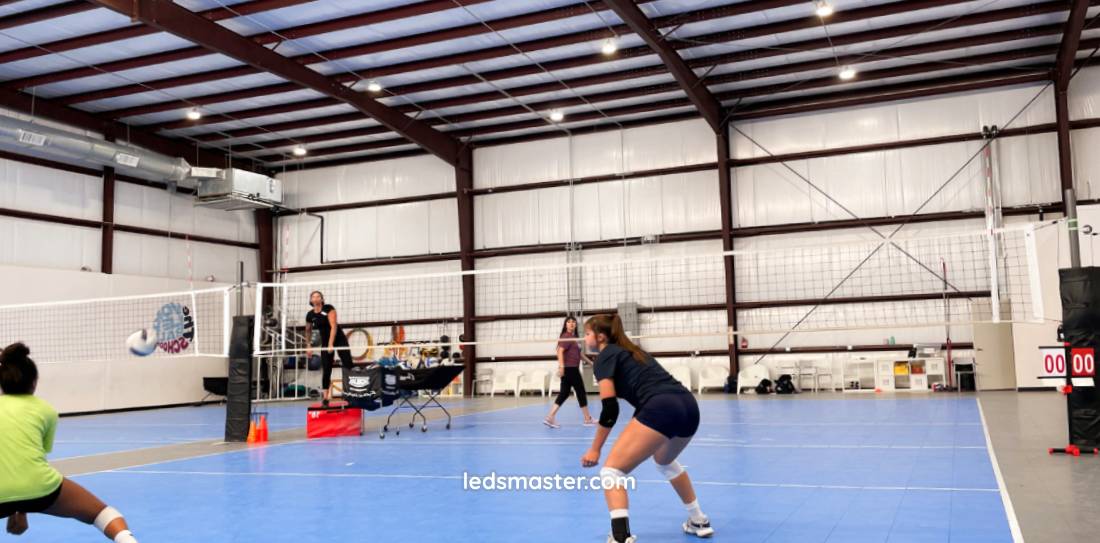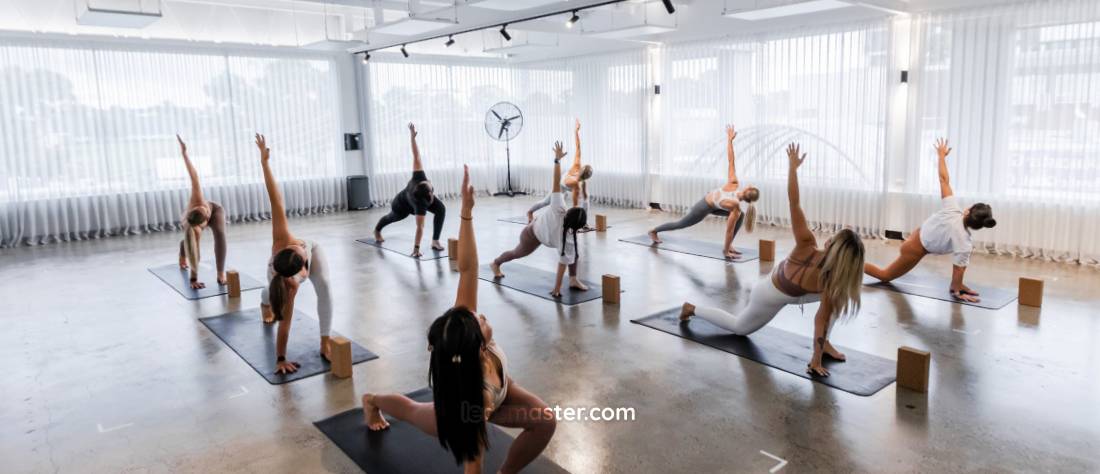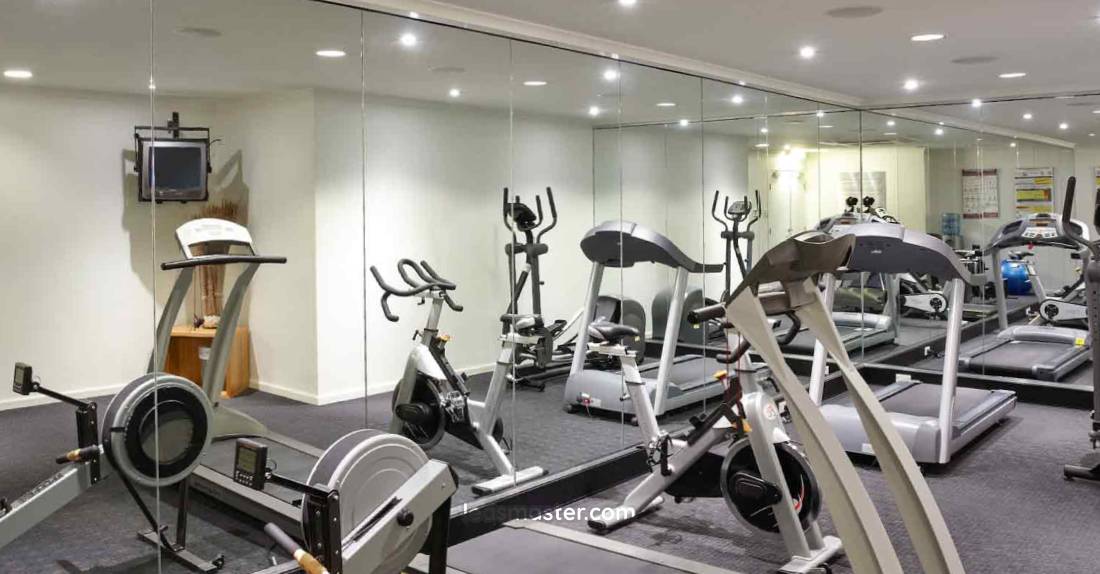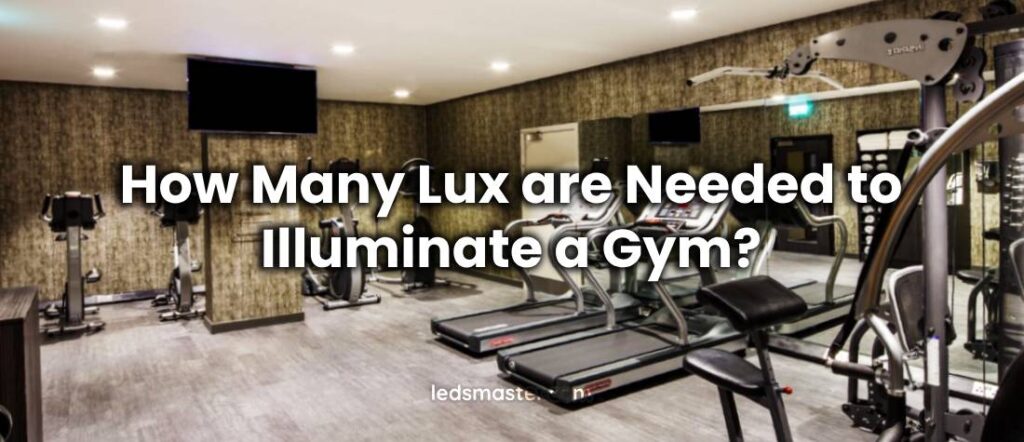Creating effective lighting for a gym involves several considerations related to brightness levels, activity types, and comfort. Lux, the unit measuring light intensity on a surface, serves as a key guide to determine how much light a gym requires for optimal use. The right illumination supports athletic performance, safety, and an inviting atmosphere.
Table of Contents
ToggleIdeal Lux Levels and Managing Glare in Gym Spaces
Creating the right lighting environment in a gym goes beyond simply achieving certain lux numbers. The overall visual experience depends on how light interacts with the space and its users, making glare management and light distribution essential for comfort and safety.
Determining Suitable Lux Levels for Different Gym Areas
| Gym Area / Activity | Recommended Lux Level Range (lux) | Notes |
|---|---|---|
| General Fitness (weightlifting, stretching, yoga) | 300 – 500 | Moderate brightness for safety and comfort |
| Sports Courts (basketball, volleyball) | 500 – 1000+ | Higher illumination for fast motion and precision |
Lighting requirements vary considerably depending on the specific functions of gym zones. Areas designed for general fitness activities such as weightlifting, stretching, or yoga typically perform well with moderate illumination levels between 300 and 500 lux. This range provides sufficient brightness for safe movement and clear visibility while maintaining a comfortable and inviting atmosphere that doesn’t overwhelm the senses.
 In contrast, sports courts and zones for high-intensity training demand increased illumination levels to accommodate rapid motion, fast visual tracking, and precision. For example, basketball and volleyball courts often require lux levels ranging from 500 to 1000 or more, ensuring players can clearly see fast-moving balls and competitors. These heightened brightness levels contribute to sharper focus and better overall performance during competitive activities.
In contrast, sports courts and zones for high-intensity training demand increased illumination levels to accommodate rapid motion, fast visual tracking, and precision. For example, basketball and volleyball courts often require lux levels ranging from 500 to 1000 or more, ensuring players can clearly see fast-moving balls and competitors. These heightened brightness levels contribute to sharper focus and better overall performance during competitive activities.
The Role of Uniformity in Visual Comfort
Uniform lighting across the gym space plays a vital role in maintaining visual comfort. Variations in brightness that create harsh shadows or intense bright spots can cause eye strain and reduce the ability to perceive the environment accurately. Careful arrangement of lighting fixtures, including attention to beam angles and spacing, helps distribute light evenly. Tools such as diffusers or reflectors aid in softening light, reducing sharp contrasts on floors and walls.
Maintaining consistent illumination throughout the space also improves safety by minimizing areas of poor visibility where accidents or collisions might occur. A well-balanced lighting design eliminates distracting glare or dark patches, supporting clear sightlines for all users.
Controlling Glare Through Fixture Design and Placement
Glare often causes discomfort and impairs vision, especially in active gym environments where focus and reaction speed are paramount. It arises when light sources are too intense or positioned in a way that directs bright light straight into the eyes. To mitigate glare, fixtures can be equipped with shields, louvers, or diffusers that control the spread and intensity of light.
Proper fixture placement is another important factor. Installing lights at appropriate heights and angles can prevent direct light from shining into the line of sight of players, trainers, or spectators. Using recessed lighting or indirect illumination techniques can further soften the environment by bouncing light off ceilings or walls rather than projecting it directly.

Adjustable Controls and Color Rendering for Flexible Environments
Because gym spaces often accommodate a wide range of activities, flexible lighting controls offer valuable adaptability. Features such as dimmers and zoned lighting systems enable operators to adjust brightness levels based on current use, conserving energy and enhancing user experience.
The quality of light also matters. Lighting with a high color rendering index (CRI) enhances the appearance of colors, making them look natural and vivid. This is especially useful in gyms, where clear perception of floor markings, equipment details, and team uniforms can influence safety and athletic performance. Lighting that renders colors accurately helps users respond better to their environment and promotes a more pleasant atmosphere overall.
Elements Influencing Required Lux Levels
Lighting a gym effectively involves many interconnected factors that shape the amount of light needed for different spaces and activities. Understanding these elements allows for creating an environment that balances visibility, comfort, and energy use.
Size and Layout of the Gym
The size of the gym space is a major determinant in the overall lighting requirements. Larger gyms demand higher light output to ensure every corner is well-lit and functional. Gyms with open floor plans or multiple zones for varied activities pose additional challenges, as lighting must be distributed evenly to avoid dark areas or uneven brightness. The layout itself—such as the positioning of walls, partitions, and heavy equipment—can create shadows or obstruct light, requiring thoughtful fixture placement and sometimes additional lighting to compensate for blocked areas.
Types of Activities and Their Lighting Needs

Different physical activities have varied lighting demands based on the nature and intensity of the sport or exercise. For example, fast-paced sports like basketball, volleyball, or indoor soccer require higher lux levels to help players track rapidly moving balls and opponents accurately. These activities benefit from bright, clear illumination that enhances reaction times and safety. In contrast, calmer activities like yoga, Pilates, or stretching benefit from softer, ambient lighting that fosters relaxation and reduces visual fatigue. Group fitness sessions can have mixed requirements—some classes might need bright, focused lighting, while others prefer dimmable, mood-enhancing illumination.
Ceiling Height and Fixture Positioning
The height of the ceiling directly affects both the intensity and the distribution of light. Gyms with high ceilings require more powerful fixtures or lamps with greater wattage because light must travel a longer distance to reach the floor level effectively. High mounting points can also create challenges with shadows and uneven lighting if fixtures are not positioned carefully. The angle and placement of fixtures matter greatly; strategically positioning lights can reduce glare and avoid casting shadows that interfere with visibility. Fixture types and mounting options vary to accommodate ceiling height, with some lighting designed specifically for tall or low ceilings.
Surface Materials and Reflectivity
The colors and finishes of interior surfaces influence how light behaves within the space. Surfaces that are light-colored or glossy reflect more light, helping to amplify overall brightness and reduce the need for additional fixtures. Conversely, darker walls and floors with matte finishes absorb more light, increasing the demand for stronger illumination to compensate for the loss. Understanding these surface characteristics can guide decisions about fixture placement and brightness levels, allowing for a more efficient lighting setup that takes advantage of natural reflectivity and minimizes wasted light.
Influence of Natural Light
The presence of natural daylight can significantly affect artificial lighting requirements. Gyms with ample windows, skylights, or glass walls benefit from daylight supplementation, which can reduce energy consumption and create a more pleasant atmosphere. However, the availability of natural light fluctuates throughout the day and seasons, affected by weather and orientation of the building. To maintain consistent illumination, artificial lighting systems often incorporate dimming controls and sensors that adjust brightness based on natural light levels, ensuring comfort while optimizing energy efficiency.
Energy Efficiency and Budget Considerations
Energy consumption and budget constraints often influence lighting choices in gym facilities. While energy-efficient technologies like LEDs may have higher upfront costs, they typically offer long-term savings through reduced electricity use and maintenance. Balancing the desire for appropriate lux levels with financial considerations might mean using zoning strategies to light only active areas or adopting hybrid lighting systems that combine different technologies. Careful planning and prioritization can help deliver the right balance of performance, visual comfort, and operational costs.
Lighting Technologies and Their Typical Lux Outputs
Selecting the right lighting technology shapes not only the quality and intensity of light in a gym but also influences energy use, maintenance demands, and user comfort. Different lighting types offer distinct characteristics that affect how well they serve the needs of varied gym activities.
Fluorescent Lighting – Moderate Brightness and Color Accuracy
Fluorescent lighting has long been a popular choice in gym environments due to its ability to deliver moderate lux levels that work well for general fitness and low-intensity activities. Typically, fluorescent fixtures produce illumination ranging from about 300 to 500 lux, which is adequate for spaces such as weight rooms, cardio areas, or stretching zones where excessive brightness isn’t required. One of the advantages of fluorescent lighting lies in its decent color rendering index (CRI), which helps maintain natural and comfortable colors, improving the visual atmosphere. Fluorescent lamps are also cost-effective upfront and generally consume less electricity than older incandescent bulbs, making them an economical choice for facility managers. However, these lights sometimes suffer from flickering or uneven light distribution, especially as they age or if the ballasts degrade. This can lead to visual discomfort and distractions during long workouts or classes. Additionally, fluorescent lamps contain small amounts of mercury, which presents environmental and disposal considerations.
Metal Halide Lamps – Bright, Intense Illumination
Metal halide lamps have traditionally been favored in gymnasiums requiring high-intensity, bright lighting such as basketball courts, volleyball courts, or multipurpose sports halls. These lamps can produce lux levels typically ranging from 500 up to 1500 or more, supporting fast-paced sports and activities that demand sharp visual acuity and quick reaction times. One of the notable strengths of metal halide lighting is its excellent color rendering, which makes colors appear vivid and natural, enhancing players’ and spectators’ experiences. However, metal halide lamps come with a few drawbacks. Their energy consumption is significantly higher than modern alternatives, and they require a warm-up period of several minutes to reach full brightness, which can be inconvenient for gyms with variable usage schedules. Metal halide bulbs also have a relatively shorter lifespan (around 6,000 to 15,000 hours), resulting in more frequent replacements and maintenance costs. Additionally, these lamps generate substantial heat, which may increase cooling loads in indoor gym environments.
LED Lighting – Energy-Efficient and Flexible Illumination

LED (Light Emitting Diode) technology has revolutionized gym lighting by offering a powerful combination of energy efficiency, long lifespan, and superior light quality. LEDs can produce a wide range of lux levels, from approximately 300 lux in general workout areas to over 1500 lux in competitive sports zones, while using far less power than metal halide or fluorescent lamps. One of the biggest benefits of LEDs is their controllability; they can be easily dimmed, zoned, or adjusted for color temperature to suit different activities and times of day, enhancing both comfort and energy savings. LED fixtures provide uniform lighting with minimal flicker and instant start-up, eliminating warm-up delays typical of older technologies. Their operational life often exceeds 50,000 hours, dramatically reducing maintenance and replacement costs. Additionally, LEDs produce less heat, which can reduce demands on HVAC systems and improve indoor climate control. These advantages have led to widespread adoption of LED lighting in new gym constructions and retrofits.
Other Older Technologies – Limited Use Due to Efficiency and Comfort
Several older lighting technologies such as incandescent and mercury vapor lamps have largely fallen out of favor in gym settings due to their lower efficiency and less suitable lighting characteristics. Incandescent bulbs emit a warm light but have very low lumen output relative to their energy consumption and require frequent replacement due to a short lifespan, making them impractical for large or active gym spaces. Mercury vapor lamps were once used in large indoor venues but tend to produce uneven illumination with poor color rendering and high glare, which can cause visual discomfort and reduce the quality of the lighting environment. Because of these factors, such technologies are rarely specified today where user experience and energy costs are major considerations.
Conclusion
Creating an effective lighting design for a gym requires balancing brightness, comfort, and the specific needs of different activities. Appropriate lux levels, uniform light distribution, and glare control all contribute to a safer and more enjoyable environment. Selecting the right lighting technology—from fluorescent to metal halide to modern LEDs—impacts energy efficiency, maintenance, and visual quality. By considering factors like gym size, ceiling height, surface reflectivity, and natural light availability, a well-planned lighting system can enhance performance, safety, and atmosphere while managing operational costs.

